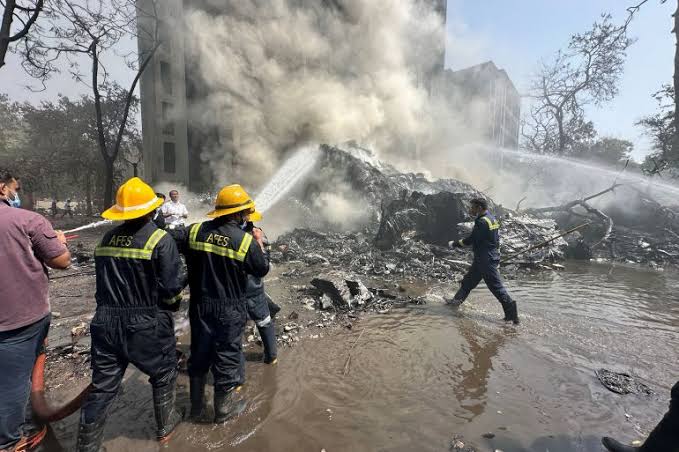Ahmedabad, June 12, 2025 — In the most catastrophic civil aviation tragedy in India’s history, an Air India flight bound for London crashed shortly after takeoff from Ahmedabad, killing all 232 people on board and leaving the nation stunned. The aircraft, operating as AI171, plummeted into the undergraduate hostel mess of B.J. Medical College in the densely populated Meghani Nagar area, causing further casualties on the ground.
At least five medical students were confirmed dead, with over 40 others injured, some critically, as the plane struck the mess hall during peak lunchtime. The scale of destruction was so severe that authorities quickly ruled out the possibility of any survivors from the aircraft. Eyewitnesses described a fiery explosion followed by intense panic, with thick black smoke engulfing the college premises.
The crash now surpasses the previous deadliest civil aviation accident in Indian history: the 1978 crash of Air India Flight 855 off the coast of Bandra, Mumbai, which claimed 213 lives. In that incident, instrument failure and spatial disorientation of the pilot were found to be the cause. Wednesday’s tragedy also eclipses the 2010 crash of Air India Express Flight 812 in Mangalore, where 158 perished when the aircraft overshot the runway.
Among other major crashes in India’s aviation history:
- Indian Airlines Flight 113 (1988): Crashed in Ahmedabad due to pilot error, killing 130 people.
- Indian Airlines Flight 605 (1990): Crashed near Bangalore — 92 deaths.
- Air India Express Flight 1344 (2020): Skidded off the Kozhikode runway — 18 deaths.
- Alliance Air Flight 7412 (2000): Crashed in Patna — 60 deaths.
- Indian Airlines Flight 171 (1976): Fire mid-air near Mumbai — 95 deaths.
- United Arab Airlines Flight 869 (1963): Went down near Bombay — 63 deaths.
In the Ahmedabad crash, the National Disaster Response Force (NDRF) deployed multiple teams to the site to aid in rescue and recovery. Gujarat Chief Minister Bhupendra Patel visited Civil Hospital to meet with the injured, including students and local residents, and reviewed medical and emergency arrangements. CM Patel described the incident as a “national catastrophe” and assured full government support to the families of the deceased and the injured.
Despite the chaos, several medical students who survived the crash joined emergency responders to assist in triage and provide first aid. B.J. Medical College has suspended academic activities and declared a period of mourning.
The Directorate General of Civil Aviation (DGCA) and the Aircraft Accident Investigation Bureau (AAIB) have launched a formal investigation. Black box retrieval and analysis are underway, with the focus on identifying the technical or human errors responsible for the incident. Air India has pledged full cooperation and compensation to the families of all victims.
The tragedy has reignited discussions on aviation safety and the placement of critical infrastructure near urban zones. Experts stress the need for tighter air traffic monitoring, stricter maintenance protocols, and reevaluation of zoning laws near busy airports.
Tributes have poured in from across India and abroad. Prime Minister Narendra Modi, President Droupadi Murmu, and global leaders have expressed deep condolences. The White House, UK Prime Minister’s Office, and United Nations have all acknowledged the disaster and offered sympathies to the victims’ families.
As India grapples with the magnitude of the loss, the nation mourns not just the passengers and crew aboard AI171, but also the young medical students—future doctors—whose lives were abruptly and senselessly cut short.

